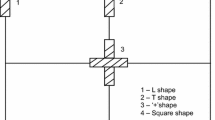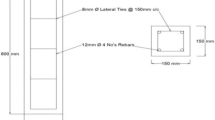Abstract
Concrete is more durable against fire than other structural materials. However, high temperature has deteriorating effects on mechanical properties of concrete. Decreases of strength at higher temperatures can be associated with various reasons, such as micro- and macro-cracks on the concrete, the volume expansion in the aggregate, and the deterioration of the calcium silicate hydrate (C–S–H) gels in the cement paste. The main objective of this research work is to study the effect of four different cooling schemes on the ultimate strength of 54 reinforced concrete columns subjected to uncontrolled fire. The tested columns are of different surface area to volume ratios (with three different cross sections; circular, square and rectangular). Four cooling schemes were used; three of them are uniform cooling schemes with different rates (rapid, slow and intermediate) while the fourth cooling scheme was non-uniform. Two different fire temperatures and durations were considered (300 °C for 3 h & 600 °C for 6 h). Non-destructive test (Core test) was used to estimate the deterioration extent of fire on concrete properties. A mathematical model was developed to estimate the ultimate strength of RC columns subjected to fire to decide if the RC columns need repair and strengthening after fire or not. Results of the model and the obtained experimental results were compared together to evaluate the accuracy of the proposed model.












Similar content being viewed by others
References
Abdulraheem, M. S., & Kadhum, M. M. (2018). Experimental investigation of fire effects on ductility and stiffness of reinforced reactive powder concrete columns under axial compression. Journal of Building Engineering, 20, 750–761.
Arel, H. S., & Yazici, S. (2014). Effect of different parameters on concrete-bar bond under high temperature. ACI Materials Journal, 111(6), 633–640.
Bikhiet, M. M., El-Shafey, N. F., & El-Hashimy, H. M. (2014). Behavior of reinforced concrete short columns exposed to fire. Alexandria Engineering Journal, 53(3), 643–653.
CRSI. (2015). Fire resistance of reinforced concrete buildings. Schaumburg: Concrete Reinforcing Steel Institute.
Du, Y., Qi, H. H., Huang, S. S., & Liew, J. R. (2020). Experimental study on the spalling behaviour of ultra-high strength concrete in fire. Construction and Building Materials, 258, 120334.
Ekmekyapar, T., & Alhatmey, I. A. (2019). Post-fire resistance of internally ring stiffened high performance concrete. Engineering Structures, 183, 375–388.
Emberley, R. L., & Leonard, D. A. (2013). A study into the behavior of reinforced-concrete columns under fire exposures using a spreadsheet-based numerical model (Doctoral dissertation, Worcester Polytechnic Institute)
Gernay, T. (2019). Fire resistance and burnout resistance of reinforced concrete columns. Fire Safety Journal, 104, 67–78.
Lang, Z., Liu, H., Meng, N., Wang, H., Wang, H., & Kong, F. (2020). Mapping the knowledge domains of research on fire safety—an informetrics analysis. Tunnelling and Underground Space Technology Incorporating Trenchless Technology Research, 108, 103676.
Lu He, Z. X. (2018). Analysis of entrainment phenomenon near mechanical exhaust vent and a prediction model for smoke temperature in tunnel fire. Tunnelling and Underground Space Technology, 80, 143–150.
Purkiss, J. A. (2007). Fire Safety Engineering Design of Structures (2nd ed.). Routledge: Taylor and Francis.
Vitorino, H., Rodrigues, H., & Couto, C. (2020). Evaluation of post-earthquake fire capacity of reinforced concrete elements. Soil Dynamics and Earthquake Engineering, 128, 105900.
Wróblewska, J., & Kowalski, R. (2020). Assessing concrete strength in fire-damaged structures. Construction and Building Materials, 254, 119122.
Xu, H., Yu, M., Xue, C., Xu, L., & Ye, J. (2020). Experimental study on fire resistance of precast concrete columns with efficient reinforcement. Engineering Structures, 204, 109947.
Zhang, Q. Q., Yuan, G. L., & Dong, Y. N. (2011). Influence of cooling methods and standing time on different aggregate concrete strengths after elevated temperature. Advanced Materials Research, 250–253, 155–159.
Author information
Authors and Affiliations
Corresponding author
Additional information
Publisher's Note
Springer Nature remains neutral with regard to jurisdictional claims in published maps and institutional affiliations.
Rights and permissions
About this article
Cite this article
Awad, Y., Kohail, M., Khalaf, M.A. et al. Effect of fire extinguishing techniques on the strength of RC columns. Asian J Civ Eng 23, 113–123 (2022). https://doi.org/10.1007/s42107-021-00414-8
Received:
Accepted:
Published:
Issue Date:
DOI: https://doi.org/10.1007/s42107-021-00414-8




